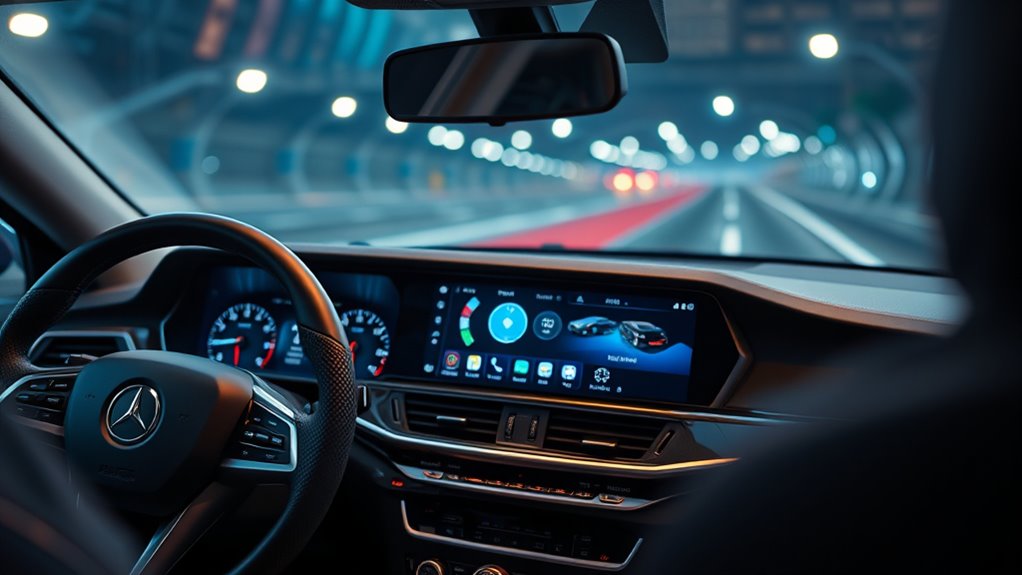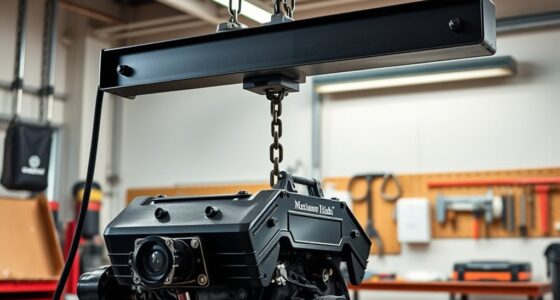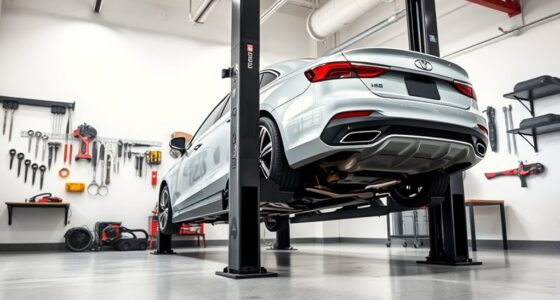I’ve researched the 13 best professional driver alert systems that boost safety and performance. These include GPS trackers with real-time updates, advanced fatigue and drowsiness warning devices, wearable alerts for high-risk drivers, weatherproof outdoor sensors, and high-tech camera-based systems with AI detection. Each offers unique features like geofencing, continuous monitoring, or environmental durability. If you keep going, you’ll discover how these innovative solutions can help protect drivers and improve road safety effectively.
Key Takeaways
- Advanced AI-based fatigue detection systems monitor driver alertness through face, eye, and head movement analysis with high accuracy.
- Wearable devices like narcolepsy alert systems and fatigue alarms provide real-time warnings for at-risk drivers.
- Vehicle monitoring devices such as GPS trackers enhance safety by tracking real-time location, speed, and geofences.
- Durable outdoor security systems with long-range sensors ensure continuous monitoring in harsh environments.
- User-friendly interfaces with auto-calibration, adjustable mounts, and smartphone integration improve safety and operational performance.
OBD GPS Car Tracker with Real-Time Location and Phone App
If you’re looking for a discreet way to monitor driving behavior and track vehicle location in real time, the OBD GPS Car Tracker with Phone App is an excellent choice. It’s small, measuring just 1 x 1.75 x 2.1 inches, and installs easily above the dash. The device supports Android and iOS, providing detailed reports on speed, harsh braking, and acceleration. It operates on 4G wireless, offering real-time updates for fleet management, teen safety, or family monitoring. While some users experience initial connection issues, overall, it’s reliable and user-friendly—ideal for those who want extensive driving insights with minimal hassle.
Best For: families, fleet managers, and insurance clients seeking discreet, real-time vehicle monitoring and driving behavior insights.
Pros:
- Compact size and easy discreet installation above the dash
- Supports both Android and iOS with detailed driving reports
- Reliable real-time GPS updates suitable for fleet and safety monitoring
Cons:
- Potential compatibility issues with certain vehicle models, especially those with advanced electronics
- Initial connection problems reported by some users requiring customer support assistance
- Discontinued product, which may limit future support and updates
Spy Tec GPS Mini Tracker for Vehicles and Loved Ones
The Spy Tec GPS Mini Tracker stands out as an ideal choice for anyone needing discreet, reliable vehicle and loved one monitoring. Its compact, weatherproof design with a durable ABS plastic casing makes it versatile for cars, boats, or assets. Weighing only 3.07 ounces, it attaches securely with powerful magnets, perfect for hidden tracking. With up to 14 days of battery life and real-time updates every 5 seconds, it keeps you informed without constant recharging. The easy-to-use app supports geofences, speed alerts, and historical data, providing extensive monitoring worldwide via 4G coverage. It’s a cost-effective, dependable tool for enhanced safety and performance.
Best For: individuals seeking discreet, reliable vehicle, asset, or loved one monitoring with extended battery life and global coverage.
Pros:
- Compact, weatherproof design with durable ABS plastic casing for versatile use
- Up to 14 days of battery life with real-time updates every 5 seconds for continuous monitoring
- Supports geofences, speed alerts, and historical data via an easy-to-use app on iOS and Android
Cons:
- Subscription plans start at $14.95/month, which may be a recurring expense for some users
- Requires a cellular network connection, so coverage and signal strength can impact performance
- Limited to 4G coverage, which might be less effective in areas with poor network infrastructure
Driver Fatigue Alarm, Car Fatigue Driving Warning Device
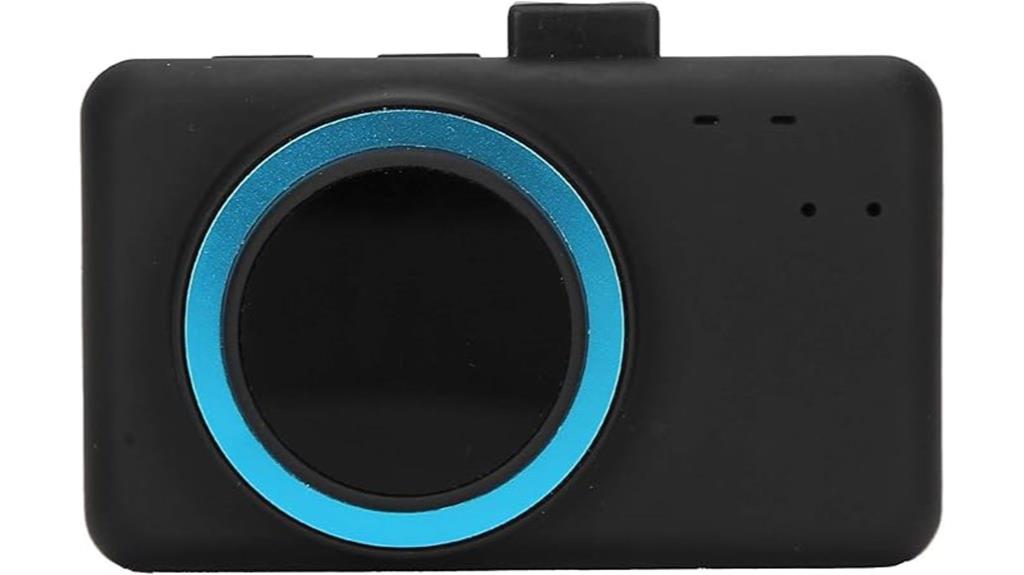
A driver fatigue alarm is an essential safety device for anyone who frequently spends long hours on the road, as it actively monitors alertness levels and warns drivers before drowsiness causes accidents. Using advanced detection technology like pupil recognition, face recognition, and blink frequency monitoring, it accurately assesses when you’re getting too tired. With a simple installation—thanks to its rotating suction cup bracket—it fits any vehicle. The device provides timely voice prompts that alert you to take a break, helping prevent fatigue-related incidents. It’s especially valuable for long-distance drivers, seniors, and truckers, promoting safer driving and peace of mind for everyone on the road.
Best For: long-distance drivers, seniors, and truck drivers seeking to enhance road safety and prevent fatigue-related accidents.
Pros:
- Utilizes advanced pupil, face, and blink detection technology for accurate fatigue monitoring.
- Easy to install with a rotating suction cup bracket compatible with all vehicle types.
- Provides timely voice alerts to prompt driver rest, promoting safer driving habits.
Cons:
- May require initial setup and calibration for optimal detection accuracy.
- Voice prompts could be disruptive in quiet driving environments.
- Dependence on electronic components means potential malfunction or need for replacement over time.
Driver Fatigue Alarm Device
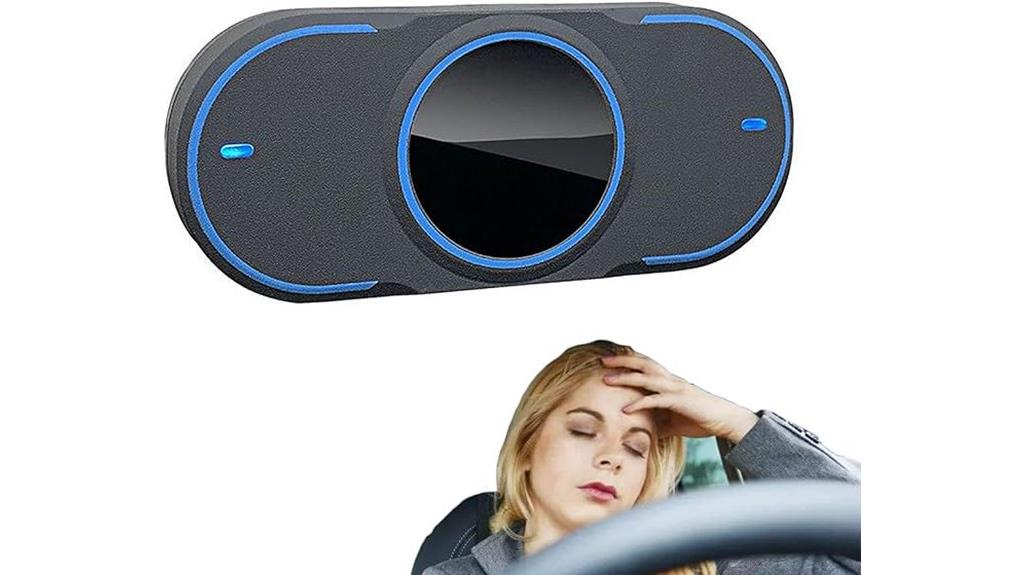
For drivers who prioritize safety and want continuous protection against drowsiness, the Driver Fatigue Alarm Device stands out with its unique feature of emitting loud alarms until the driver awakens. I find its Vision AI algorithm impressive, using high-definition cameras to monitor eye, face, and head movements with 99.9% accuracy in detecting fatigue. The device’s real-time analysis, powered by a dual-core high-performance chip, assesses driver alertness up to 20 times per second. Easy to install on various vehicles, it guarantees constant vigilance and prevents accidents caused by drowsiness. This reliable system keeps me alert, providing peace of mind on long journeys or demanding drives.
Best For: drivers who prioritize safety and need continuous protection against drowsiness during long or demanding journeys.
Pros:
- Continuous loud alarm until the driver wakes up, ensuring alertness.
- Highly accurate Vision AI algorithm with 99.9% detection precision for fatigue signs.
- Easy to install on various vehicle types with real-time monitoring for immediate response.
Cons:
- May cause inconvenience with persistent alarms if the driver is momentarily distracted.
- Dependence on camera placement and lighting conditions for optimal performance.
- Potential false alarms in certain situations, such as strong sunlight or reflections.
Narcolepsy Driver Alertness System
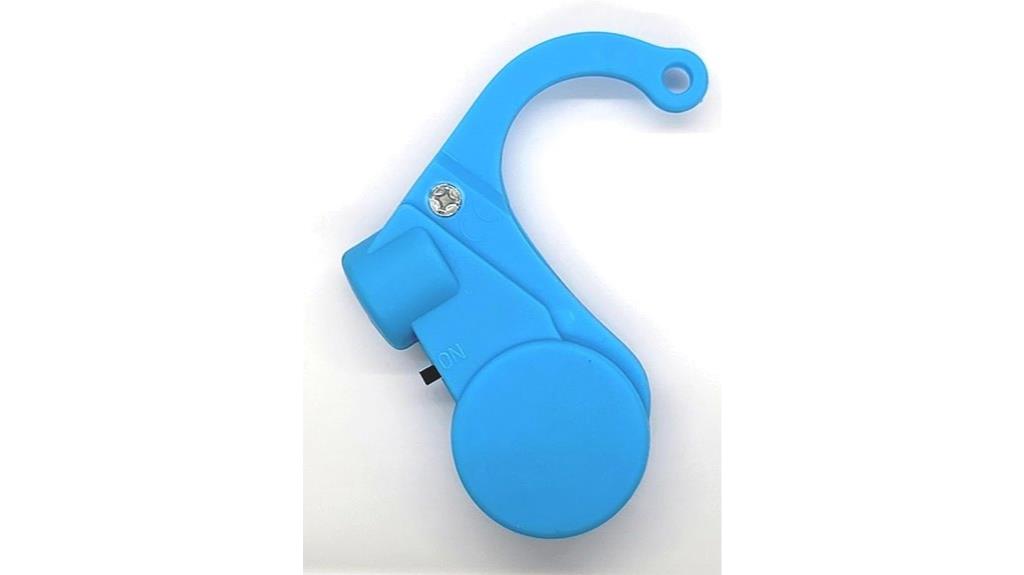
If you’re a driver with narcolepsy or prone to sudden drowsiness behind the wheel, the Narcolepsy Driver Alertness System, like the NOD-Stopper, could be an essential safety tool. This lightweight device, worn over the ear, uses motion sensors to detect signs of drowsiness and sounds an alarm to keep you alert. It’s designed to reduce the risk of falling asleep during long drives or monotonous routes. While some users find it helpful, reviews are mixed regarding its reliability. Still, for high-risk drivers, having a system that prompts alertness can be a critical safety measure on the road.
Best For: drivers with narcolepsy or those prone to sudden drowsiness who need an alertness aid during long or monotonous drives.
Pros:
- Lightweight and comfortable to wear over the ear.
- Uses motion sensors to monitor driver alertness and provides timely warnings.
- Designed specifically for high-risk drivers to enhance road safety.
Cons:
- Customer reviews indicate inconsistent reliability and performance issues.
- Some users report the device emits continuous squealing sounds or fails to activate properly.
- Limited warranty and mixed feedback on customer support and product durability.
Anti-Sleep Alarm Monitor for Drivers
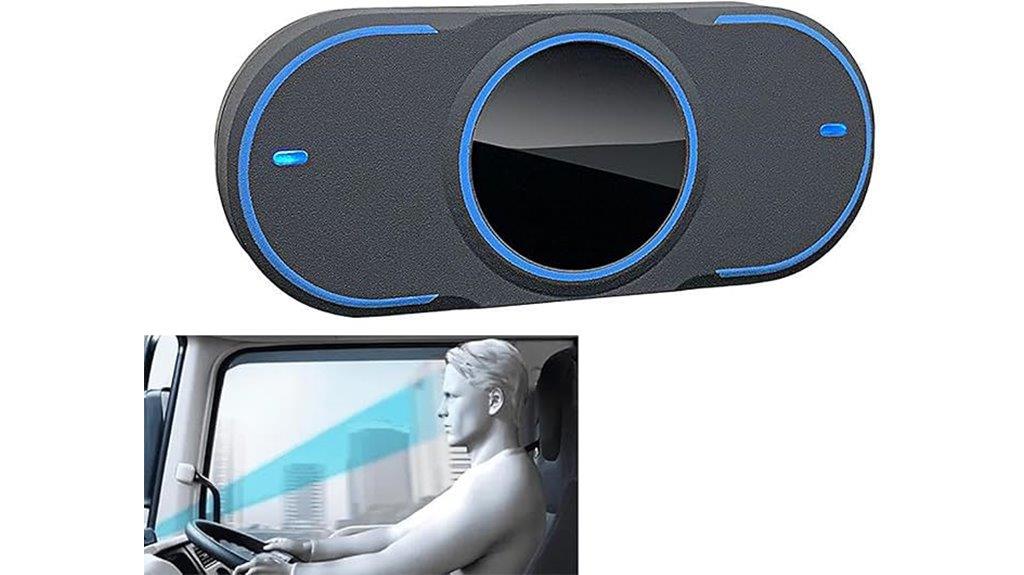
Long-haul drivers who need reliable fatigue detection will find the Anti-Sleep Alarm Monitor especially valuable, as it continuously tracks alertness with high accuracy. Equipped with a high-definition camera and intelligent AI algorithms, it monitors face, eye, and head movements in real time, detecting signs of drowsiness up to 20 times per second. When fatigue is identified, it triggers a loud alarm until the driver wakes up, preventing potential accidents. Easy to install on the dashboard or windshield, the system offers seamless operation and reliable alerts. Its advanced technology guarantees drivers stay alert, enhancing safety and reducing fatigue-related risks on long trips.
Best For: long-haul truck drivers and commercial drivers seeking reliable, real-time fatigue detection to enhance safety during extended driving hours.
Pros:
- High-precision AI technology detects drowsiness with 99.9% accuracy.
- Easy to install on dashboard, windshield, or center console without complex setup.
- Continuous real-time monitoring with loud alarm alerts to prevent accidents.
Cons:
- May require initial calibration for optimal face and eye detection.
- Alarm sound could be disruptive in quiet driving environments.
- Dependence on camera positioning; improper placement may affect performance.
Driver Fatigue Alarm Device for Drivers and Security Guards
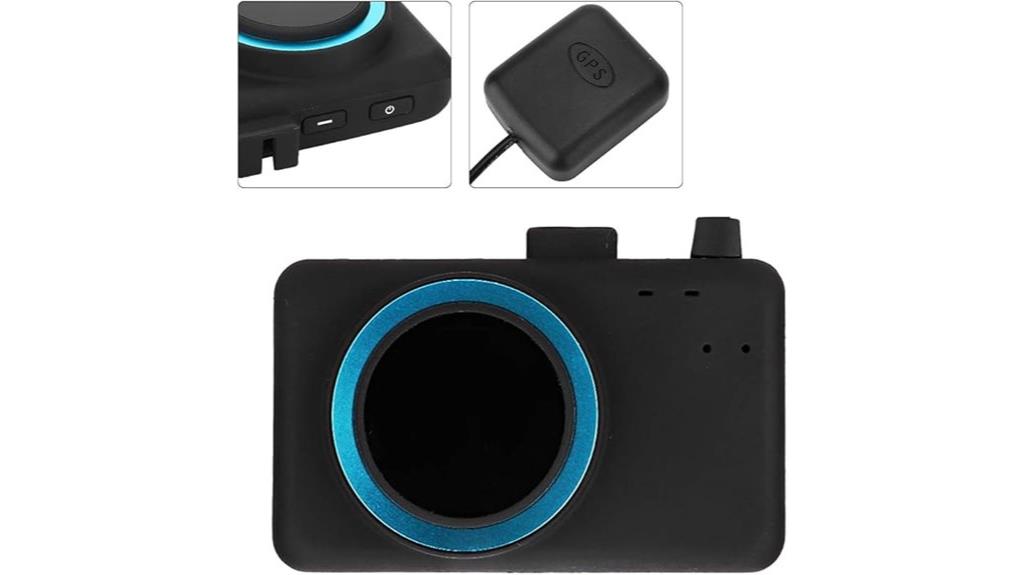
The Driver Fatigue Alarm Device stands out as an essential tool for drivers and security guards who need to stay alert during long shifts or critical operations. It uses advanced face recognition and pupil detection technology to monitor alertness in real-time. The device quickly detects signs of fatigue or distraction within 1-2 seconds, even when the driver wears glasses or sunglasses. When it identifies signs of drowsiness, it immediately sounds an alarm to alert the driver to take action. This quick, accurate detection helps prevent accidents, protect lives, and improve overall safety, making it a crucial addition to any professional driving environment.
Best For: professional drivers and security personnel who need reliable, real-time fatigue monitoring to ensure safety during long shifts or critical operations.
Pros:
- Provides instant alerts to prevent drowsiness-related accidents
- Uses advanced face and pupil recognition technology compatible with all skin types and eyewear
- Enhances safety by offering quick, accurate detection of fatigue or distraction
Cons:
- May require proper calibration and positioning for optimal detection accuracy
- Potential false alarms if facial features are obstructed or lighting conditions are poor
- Dependence on consistent device maintenance and updates for optimal performance
Fatigue Driving Alarm Device with Real-Time Warning
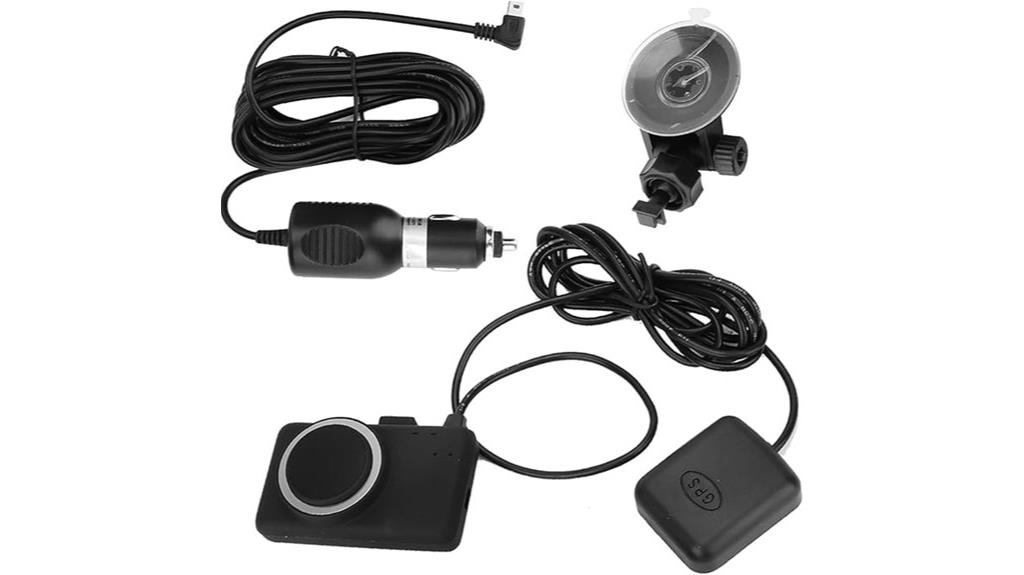
Drivers who want to stay alert and prevent drowsiness on the road will find the Fatigue Driving Alarm Device indispensable. It offers real-time warnings by continuously monitoring my alertness using advanced face recognition and pupil detection technology. Within seconds of detecting signs of fatigue or distraction, it sounds a loud alarm, helping me stay focused and avoid accidents. The device works effectively regardless of my appearance or accessories like glasses. Lightweight and easy to install, it’s compatible with standard car chargers and operates reliably across various temperatures. This device is a crucial safety tool for anyone committed to safer driving and enhanced performance.
Best For: drivers who want to maintain alertness, prevent drowsiness, and ensure safety during long or stressful trips.
Pros:
- Provides real-time fatigue warnings with loud alarms for immediate driver alerts
- Utilizes advanced face recognition and pupil detection technology for accurate monitoring
- Compatible with all skin types and accessories like glasses, ensuring versatile use
Cons:
- Requires a power source and installation in the vehicle, which may take some setup time
- May be less effective in extremely low-light conditions without additional lighting support
- Slightly larger size may be noticeable or inconvenient for some users
Assistant Sleeping Alarm for Drivers
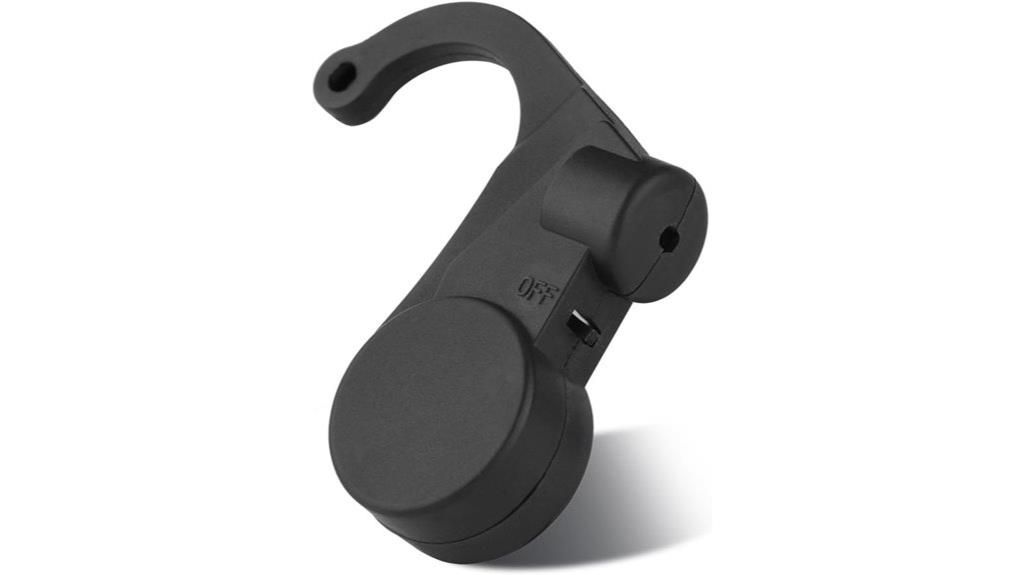
If you often work night shifts or find yourself at risk of nodding off behind the wheel, the Assistant Sleeping Alarm is an essential tool to keep you alert. This device detects signs of drowsiness using motion sensor technology and sounds an audible alarm only for you, preventing disturbances to others. Its simple, lightweight design makes it easy to carry and operate, perfect for drivers, security personnel, or medical staff during long or late shifts. Powered by just four batteries, it’s straightforward to set up and maintain. With positive reviews and a compact form, this alarm helps guarantee your safety on the road.
Best For: drivers, security personnel, medical staff, and night shift workers who need a reliable alert to prevent drowsiness while working or driving.
Pros:
- Simple and intuitive operation suitable for all users.
- Audible alarm alerts only the wearer, avoiding disturbance.
- Compact, lightweight design makes it easy to carry and install.
Cons:
- Relies on batteries, which need replacement over time.
- Detection accuracy may vary with different user movements.
- Limited to basic alarm functions without additional features.
Driver Fatigue Alarm Device for Cars
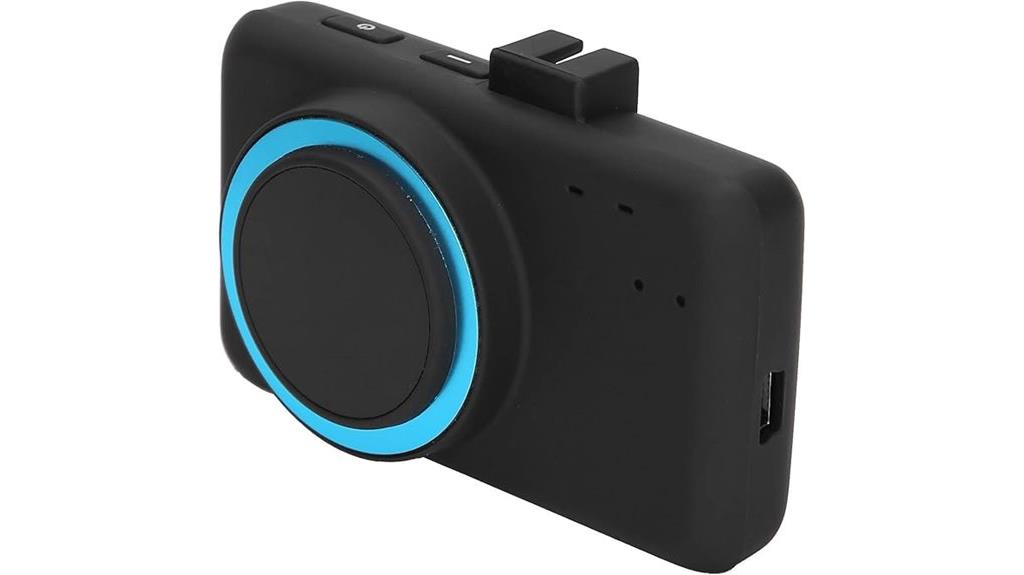
For anyone who spends long hours behind the wheel, a Driver Fatigue Alarm Device offers essential safety benefits. This device monitors driver alertness in real-time using infrared sensors and pupil detection technology to analyze facial features. It detects signs of fatigue or inattention precisely and promptly issues warnings to prevent accidents. Easy to install with a versatile rotating bracket, it fits all vehicle types. Powered by a 12V or 24V supply, it provides continuous, non-intrusive monitoring. By alerting drivers before fatigue affects their performance, it considerably reduces the risk of accidents, making long drives safer for everyone on the road.
Best For: drivers, truck operators, and security personnel who need reliable real-time fatigue monitoring to ensure safety during long hours on the road.
Pros:
- Accurate detection of driver fatigue using advanced infrared and pupil recognition technology
- Easy to install with a versatile rotating bracket compatible with all vehicle types
- Continuous, non-intrusive monitoring that enhances safety without distracting the driver
Cons:
- Requires a stable power supply of 12V or 24V, which may need installation adjustments in some vehicles
- May have limitations in extremely low-light conditions if infrared sensors are not properly calibrated
- Initial setup and calibration might require technical knowledge for optimal performance
Hosmart Wireless Driveway Alarm System with Motion Sensor and Weatherproof Detector

The Hosmart Wireless Driveway Alarm System stands out as an ideal choice for those needing reliable outdoor security across large properties or rural areas. Its weatherproof design, made with industrial-grade PVC and water-resistant seals, guarantees durability in harsh conditions. With a wireless range of up to half a mile, it detects movement from humans, vehicles, or large animals, and can be expanded with multiple sensors and receivers. The system offers customizable sensitivity and fun ringtones, making it easy to identify different zones. Easy to install and built to last, it provides dependable alerts for driveway monitoring, wildlife deterrence, and perimeter security.
Best For: homeowners, rural property owners, and outdoor security users seeking a durable, long-range driveway alarm system for perimeter monitoring and wildlife deterrence.
Pros:
- Highly reliable with a wireless range of up to 1/2 mile, effective in various challenging environments
- Weatherproof construction with industrial-grade PVC housing ensures durability in harsh outdoor conditions
- Expandable system supports multiple sensors and receivers for comprehensive perimeter coverage
Cons:
- Some false alarms may occur due to sun glare or wildlife, requiring sensitivity adjustments
- Initial setup and angle tuning might be necessary for optimal performance
- Battery replacement needed approximately once a year, depending on usage
Car Fatigue Warning Alarm Device
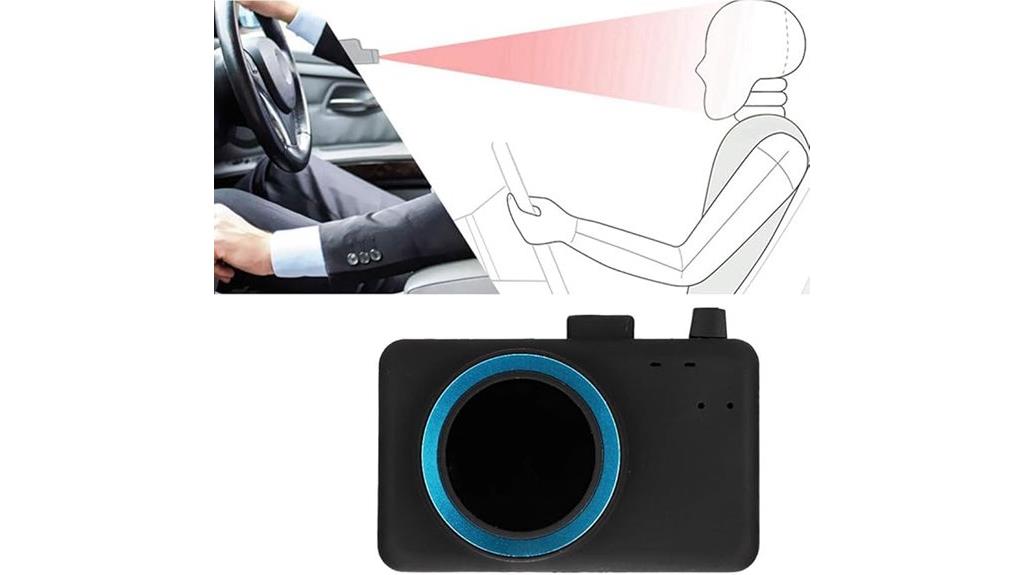
A car fatigue warning alarm device is essential for drivers who prioritize safety and want a reliable alert system to prevent drowsiness-related accidents. This compact, lightweight device easily attaches with a suction cup and plugs into your cigarette lighter, making installation simple. It uses advanced face recognition technology to monitor signs of fatigue or distraction in real-time, regardless of skin type or whether you’re wearing glasses. While some users find the alarm volume low, its timely alerts can help you stay alert on long drives. Overall, this device enhances safety by providing immediate warnings, reducing the risk of accidents caused by driver drowsiness.
Best For: drivers who prioritize safety and seek a portable, real-time fatigue alert system to prevent drowsiness-related accidents.
Pros:
- Compact and lightweight design that doesn’t obstruct driver’s view
- Easy to install with suction cup bracket and cigarette lighter plug
- Uses advanced face recognition technology suitable for all skin types and eyewear
Cons:
- Alarm volume is often reported as too low, reducing alert effectiveness
- No wireless remote control feature available
- Customer ratings are low, indicating potential reliability or user experience issues
Apple Carplay Screen for Car with Dash Cam & Backup Camera

An Apple Carplay screen integrated with a dash cam and backup camera offers a seamless driving experience for those who prioritize safety and tech convenience. Its large 10.26-inch HD touchscreen makes navigation, calls, and media easy to access, while wireless connectivity supports Apple Carplay, Android Auto, AirPlay, and Miracast. The dual-lens dash cam captures 4K front and 1080P rear footage, with features like motion detection and AI tracking. Safety alerts like collision warnings and lane departure assist drivers in staying alert. Despite some connectivity and audio quirks, this system enhances safety, offers intuitive control, and integrates vehicle tech efficiently—making it a valuable upgrade for modern drivers.
Best For: drivers seeking an integrated, large-screen infotainment system with advanced safety features and dash cam recording capabilities.
Pros:
- Large 10.26-inch HD touchscreen offers intuitive control and clear visibility.
- Wireless connectivity supports Apple Carplay, Android Auto, AirPlay, and Miracast for seamless integration.
- Dual-lens dash cam captures high-quality 4K front and 1080P rear footage with safety alert features.
Cons:
- Occasional Bluetooth disconnections and AUX audio noise can affect user experience.
- Mounting options may feel flimsy or lose adhesion over time, especially in cold weather.
- Some issues with SD card formatting and recording reliability after extended use.
Factors to Consider When Choosing Professional Driver Alert Systems
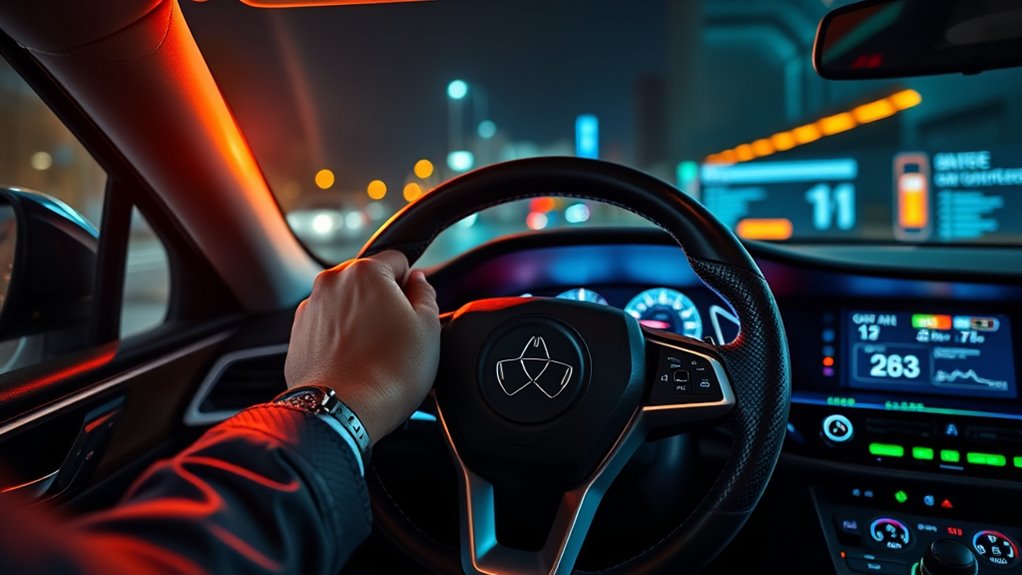
When selecting a professional driver alert system, I look at how accurate the detection technology is to guarantee reliable warnings. I also consider device compatibility and how quickly it responds to alerts, since timing can be critical. Finally, I keep in mind installation ease and power requirements to make sure it fits seamlessly into my vehicle setup.
Detection Technology Accuracy
Choosing a driver alert system with high detection technology accuracy is essential because it directly impacts your safety on the road. High-precision systems can identify fatigue or distraction events almost perfectly, often reaching near 99.9% accuracy. They use AI algorithms, pupil recognition, and facial movement analysis to reliably monitor driver alertness. The quality of sensors—like infrared cameras and fast digital processors—plays a critical role in real-time analysis. However, environmental factors such as lighting or driver accessories can cause false positives or negatives if the algorithms aren’t properly calibrated. To maintain peak performance, regular updates and calibration are indispensable as driver behaviors and vehicle conditions change. Prioritizing accuracy ensures you’re alerted promptly and correctly, reducing risks and enhancing safety.
Device Compatibility Range
Ensuring your driver alert system works seamlessly with your vehicle is key to maximizing safety and avoiding technical issues. I always check that the device is compatible with my car’s make, model, and electronic system complexity to prevent malfunctions. It’s also essential to verify support for the right power supply and connection types, like OBD ports, USB, or 12V sockets, ensuring easy integration. I confirm the system works with my smartphone’s operating system, whether Android or iOS, for smooth app updates and management. Additionally, I consider if the device suits different vehicle sizes and types, from cars to trucks, for versatile use. Finally, I confirm it can connect with existing sensors or external devices, providing thorough safety coverage across all driving situations.
Alert Response Speed
Have you ever wondered how quickly a driver alert system can notify you of fatigue or distraction? Speed is critical—ideally, alerts should trigger within 1-2 seconds. Modern systems use high-speed digital processors that analyze facial and eye movements multiple times per second, ensuring rapid detection of drowsiness or distraction signs. Real-time face recognition and pupil detection technology further enhance response times, allowing for immediate warnings at the first indication of fatigue. Any delay can decrease the system’s effectiveness, giving drivers more time to react inadequately and increasing accident risk. *Consequently*, choosing a system with seamless, instant detection and alert mechanisms is essential for maximizing safety and performance. Quick response times truly make all the difference on the road.
Installation Simplicity
When selecting a driver alert system, installation ease can considerably impact your experience and safety. I recommend choosing models with plug-and-play designs, like suction cups or magnetic mounts, for quick, tool-free setup. Adjustable mounting options, such as dashboards or windshields, allow for ideal positioning and better visibility. Look for devices that require minimal wiring—preferably connecting to existing power sources like cigarette lighters or USB ports—saving time and reducing hassle. Clear, step-by-step instructions and user-friendly interfaces help prevent errors and streamline the process. Additionally, systems with auto-calibration or self-setup features make initial configuration simple, ensuring the system adapts easily to your vehicle. Prioritizing installation simplicity ensures you can get your alert system operational quickly and safely.
Battery and Power Needs
Choosing a driver alert system with reliable power options is essential for uninterrupted safety monitoring. I look for systems with solid power sources like rechargeable batteries or direct vehicle connections to guarantee continuous operation. It’s important to check the battery life specifications; some devices last up to 14 days on a single charge, which reduces maintenance. I also prefer systems that support quick and easy power setup, such as cigarette lighter adapters or direct wiring, for seamless installation. Additionally, features like automatic power-saving modes or low-battery alerts help prevent unexpected shutdowns during critical moments. Finally, I evaluate the device’s power consumption rate to ensure it doesn’t interfere with the vehicle’s electrical system or drain the battery excessively, maintaining reliable performance at all times.
Environmental Durability
Ensuring a driver alert system can survive tough conditions is crucial for dependable safety monitoring. Devices must withstand extreme temperatures, moisture, dust, and impacts to stay operational. Look for systems rated with weatherproof or waterproof enclosures, like IP65 or higher, to guarantee durability against rain, snow, or dirt. Shock and vibration resistance are essential in rugged environments such as construction sites or off-road scenarios, preventing false alarms or malfunctions. The materials used should include reinforced plastics, corrosion-resistant metals, and sealed connectors to guard against environmental damage. Choosing systems with high environmental durability reduces ongoing maintenance and guarantees continuous operation, which directly enhances safety. Investing in robust, durable systems means fewer disruptions and more reliable alert performance under challenging conditions.
Frequently Asked Questions
How Do Driver Alert Systems Integrate With Existing Vehicle Safety Features?
Driver alert systems seamlessly integrate with existing vehicle safety features by connecting to the vehicle’s onboard computer and sensors. I’ve seen how they work together to monitor driver behavior, alerting me if I get drowsy or distracted. They also sync with systems like airbags and ABS to enhance overall safety. This integration creates a all-encompassing safety network, giving me peace of mind and helping prevent accidents.
What Maintenance Is Required for These Professional Driver Alert Systems?
Maintaining these alert systems is like tending to a delicate garden; regular checks keep everything in bloom. I routinely clean sensors, update software, and inspect wiring to guarantee peak performance. Replacing worn components and calibrating sensors as recommended by manufacturers also help avoid potential hiccups. By staying proactive with these simple tasks, I ensure my system remains reliable, enhancing safety and efficiency on every journey.
Are Driver Alert Systems Suitable for Commercial Fleet Management?
Absolutely, driver alert systems are highly suitable for commercial fleet management. They help me monitor driver alertness, prevent fatigue, and improve safety across my fleet. These systems provide real-time alerts that keep drivers focused and reduce accidents. Implementing them enhances overall efficiency, lowers insurance costs, and promotes a safety-first culture. I find that investing in such technology benefits both my drivers and my business long-term.
How Do Alert Systems Differentiate Between Driver Fatigue and Distraction?
While it’s delicate to distinguish between fatigue and distraction, alert systems analyze subtle cues like steering patterns, eye movements, and facial expressions. I’ve found that advanced sensors and AI algorithms work together to interpret these indicators, gently differentiating between tiredness and inattentiveness. This nuanced approach helps guarantee drivers receive timely alerts tailored to their specific state, promoting safety without overreacting to minor variances.
What Are the Legal Considerations for Installing Driver Alert Systems in Commercial Vehicles?
When I install driver alert systems in commercial vehicles, I guarantee I comply with all relevant laws and regulations, like obtaining necessary permits and following data privacy rules. I also stay updated on local and federal requirements, including FMCSA regulations. It’s important to document the installation process and inform drivers about how their data will be used, so I avoid legal issues and promote transparency and safety on the road.
Conclusion
So, after all this talk about high-tech alerts and safety systems, you’d think we’re just waiting for robots to take the wheel, right? Ironically, the best defense is still a vigilant driver armed with the right tools. Whether it’s a GPS tracker or fatigue alarm, these systems are here to help us stay safe—because, let’s face it, who really wants to be the driver that technology has to rescue?
